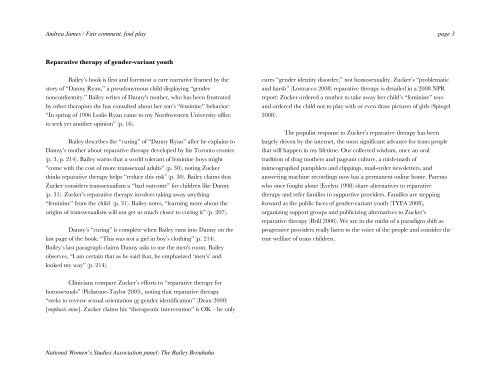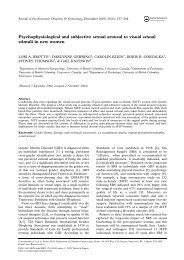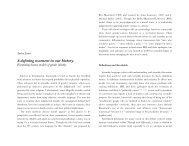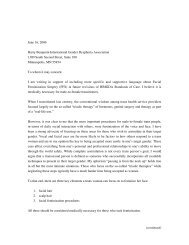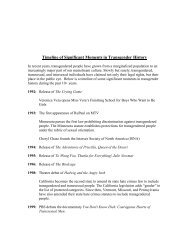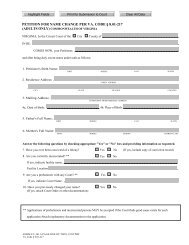Fair comment, foul play: - Transsexual Road Map
Fair comment, foul play: - Transsexual Road Map
Fair comment, foul play: - Transsexual Road Map
You also want an ePaper? Increase the reach of your titles
YUMPU automatically turns print PDFs into web optimized ePapers that Google loves.
Andrea James / <strong>Fair</strong> <strong>comment</strong>, <strong>foul</strong> <strong>play</strong> page 3<br />
Reparative therapy of gender-variant youth<br />
Bailey’s book is first and foremost a cure narrative framed by the<br />
story of “Danny Ryan,” a pseudonymous child dis<strong>play</strong>ing “gender<br />
nonconformity.” Bailey writes of Danny's mother, who has been frustrated<br />
by other therapists she has consulted about her son’s “feminine” behavior:<br />
“In spring of 1996 Leslie Ryan came to my Northwestern University office<br />
to seek yet another opinion” (p. 16).<br />
Bailey describes the “curing” of “Danny Ryan” after he explains to<br />
Danny’s mother about reparative therapy developed by his Toronto cronies<br />
(p. 3, p. 214). Bailey warns that a world tolerant of feminine boys might<br />
“come with the cost of more transsexual adults” (p. 30), noting Zucker<br />
thinks reparative therapy helps “reduce this risk” (p. 30). Bailey claims that<br />
Zucker considers transsexualism a “bad outcome” for children like Danny<br />
(p. 31). Zucker’s reparative therapy involves taking away anything<br />
“feminine” from the child (p. 31). Bailey notes, “learning more about the<br />
origins of transsexualism will not get us much closer to curing it” (p. 207).<br />
Danny’s “curing” is complete when Bailey runs into Danny on the<br />
last page of the book: “This was not a girl in boy’s clothing” (p. 214).<br />
Bailey’s last paragraph claims Danny asks to use the men's room. Bailey<br />
observes, “I am certain that as he said that, he emphasized ‘men’s’ and<br />
looked my way” (p. 214).<br />
cures “gender identity disorder,” not homosexuality. Zucker’s “problematic<br />
and harsh” (Lostracco 2008) reparative therapy is detailed in a 2008 NPR<br />
report: Zucker ordered a mother to take away her child’s “feminine” toys<br />
and ordered the child not to <strong>play</strong> with or even draw pictures of girls (Spiegel<br />
2008).<br />
The populist response to Zucker’s reparative therapy has been<br />
largely driven by the internet, the most significant advance for trans people<br />
that will happen in my lifetime. Our collected wisdom, once an oral<br />
tradition of drag mothers and pageant culture, a mish-mash of<br />
mimeographed pamphlets and clippings, mail-order newsletters, and<br />
answering machine recordings now has a permanent online home. Parents<br />
who once fought alone (Evelyn 1998) share alternatives to reparative<br />
therapy and refer families to supportive providers. Families are stepping<br />
forward as the public faces of gender-variant youth (TYFA 2008),<br />
organizing support groups and publicizing alternatives to Zucker’s<br />
reparative therapy (Brill 2008). We are in the midst of a paradigm shift as<br />
progressive providers really listen to the voice of the people and consider the<br />
true welfare of trans children.<br />
Clinicians compare Zucker’s efforts to “reparative therapy for<br />
homosexuals” (Pickstone-Taylor 2003), noting that reparative therapy<br />
“seeks to reverse sexual orientation or gender identification” (Dean 2000)<br />
[emphasis mine]. Zucker claims his “therapeutic intervention” is OK – he only<br />
National Women’s Studies Association panel: The Bailey Brouhaha


